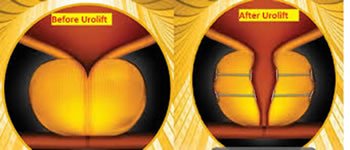Prostate matters is a not for profit organisation committed to providing free information about prostate issues from leading Clinical Authorities.
Treatment of Benign Prostatic Hyperplasia (BPH) – Urolift

Overview by Mr Neil Barber
Consultant Urologist
Frimley Health NHS Foundation Trust

The Prostatic Urethral Lift (PUL) procedure using the UroLift device
UroLift surgery for enlarged prostate is a relatively non-invasive approach to treating symptomatic BPH that lifts or holds the enlarged prostate tissue out of the way so it no longer blocks the urethra. There is no cutting, heating or removal of prostate tissue. In essence it is a technique that employs the concept of the stent to achieve a mechanical widening of the prostatic urethra. Extensive clinical data from a number of high quality trials have shown that the UroLift System is safe and effective in relieving lower urinary tract symptoms due to BPH, that it does so in a reproducible fashion and with medium to long term efficacy (5 year data published). It is this weight of clinical data that has led Urolift to receive Level1b recommendation from the European Association of Urology, as well as being identified by the NHS Accelerated Access Collaborative, as one of 10 technologies that would attract central government support to encourage implementation and delivery through the NHS in England and Wales.
The Prostatic Urethral Lift (PUL) or urolift procedure is performed under sedation or short general anesthetic and takes less than 15 minutes and is always performed as a daycase. >80% of men will be discharged home WITHOUT a urinary catheter that same day, enabling them to return to normal activities in a matter of days. As a mechanical procedure, patients commonly report a rapid improvement in urinary symptoms as any post- operative symptoms settle – i.e. in a week or 2 – not the 3 months or so that it often takes following any heat based technique.
Perhaps the biggest attraction for men to urolift across the globe is that whilst the level of symptom improvement is not comparable to procedures that remove tissue eg TURP, lasers or even Aquablation of the Prostate, it remains the only procedure that does improve waterworks symptoms with evidence to assure patients of complete maintenance of normal ejaculation and sensation on ejaculation as well as no deterioration of erectile function.
Urolift is generally an attractive option for those on medication, who might seek to gain further improvement in symptoms and stop taking tablets with no risk of impact upon sexual function or those for whom medication is not an attractive option, has been giving side effects or simply has not worked/ stopped working and standard surgical options such as TURP and its traditionally accepted risks, is just not a viable choice. It is often that same group who want to avoid a post procedure urinary catheter if at all possible and be back to normal activities in days, including work.
Urolift is not appropriate for all, and there is a prostate gland size limitation of 80 – 100ml. Furthermore, whilst employing the traditional approach in terms of Urolift implant delivery, men with obstructing median or middle lobes were not suitable, more advanced techniques, however, can be employed in this situation, published data from an FDA extension trial conforming efficacy in this group of men. New, early trial data also demonstrates a potential role for UroLift surgery for enlarged prostate in appropriate men suffering with acute urinary retention.

Prostate matters is a not for profit organisation that is committed to providing free expert advice about prostate issues from leading Clinical Authorities
In memory of Riki
PROSTATE MATTERS
Copyright Disclaimer: We try to acknowledge copyright as appropriate. If we have used something without acknowledging copyright, this is inadvertent. Please let us know by emailing info@prostatematters.co.uk
Site design and technical development by Webtoys | Intelligent Digital Media

